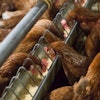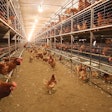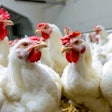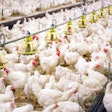
To comprehend where the U.S. currently is economically within the food industry, we must first understand where we are and where we have been. The meat business is always evolving and changing, David Williams, senior vice president of Informa Economics explained during a presentation at the 2017 Chicken Marketing Summit in Asheville, North Carolina, on July 17.
Williams referred to various covers of Time Magazine to show trends in previous years. In the seventies, a cover talked about the change in meat prices and the push to stay away from meat to avoid high costs. In the eighties, a cover discussed avoiding products with high levels of cholesterol. The early nineties pushed for consumers to become vegetarians.
Williams previously worked for Cargill. In 2004, after a small recession, low carb diets changed everything. “Meat consumption per pound went way up, it changed the habits of our consumers and they haven’t looked back since,” Williams said.
With every change, consumers and producers are forced to ask themselves the same question: What is the real cost of cheap food? While the U.S. continues to be the leader in mass production of food, there is consumer choice in how producers are meeting the demands of their wants and needs.
What is next for the food industry?
Williams referenced a video from The Late Show with Stephen Colbert. In the video, the consumer is shown going through multiple boxes to ultimately get the banana she ordered and had delivered to her house. The internet has made consumers capable of shopping without ever leaving the comfort of their home, Williams explained. Amazon is doing a wonderful job of getting products to the consumers cheaper and at the customers convenience he added. “We haven’t seen an impact of this on the food side of consumer demands, but that is fixing to change,” Williams said.
“For the food industry, this will completely change how we look at things and where we are going in the next two to five years,” he continued. Williams sees groceries being delivered straight to a consumer’s home as potentially the next big trend within the industry.
Williams explained that it will be vital for not only the poultry industry but also the entire food industry to develop strategies to the always adapting, smarter consumers that are now exposed to more information through technology.
International trade in the poultry industry
April data showed a reduction in exports within the chicken industry. Some of that could have to do with U.S. pork exports in May being the fourth highest ever on record. Globally, economists are seeing an expansion in protein.
Williams was in Mexico last month talking with livestock producers. On the chicken side, producers there were looking to produce eight to 15 percent more product in the next two years. This expansion is happening in other areas of the world as well, such as Brazil, Europe and the U.S.
Find more global poultry production trends and statistics with WATTAgNet Market Data.
Mexico is the world’s largest importer of U.S. broiler meat. Mexico imported just 98 million pounds of U.S. broiler meat during the month of April, down from 110 million during March. That was the first time since April 2012 that the country imported less than 100 million pounds of U..S broiler meat. Again, some of this could have to do with the cheaper cost of pork and beef and the country's option to buy those products at lower prices.
Much like Mexico, Asia plays a key role in the U.S. poultry market. Both supply and demand for broiler meat have been largely affected in Asian markets. South Korea has been dealing with its largest outbreak of avian influenza. The disease has not only hindered domestic consumption there, but also damaged the demand for broilers as the strain they are dealing with has caused a record amount of human deaths, Williams explained.
Recently China got the go-ahead to ship frozen, fully-cooked broiler meat to the U.S. as a tradeoff for getting to ship U.S. beef back into China. The agreement between the two governing bodies was designed to open trade routes and reduce China’s trade deficit because the product coming from China is now USDA approved.
“More than likely, the U.S. will see direct access to Chinese markets, which at one time represented a $750 million/year industry. Broiler consumption in India is expected to be on the rise as a countereffect to the government outlawing beef consumption,” Williams said.
Asia is not the only country currently having struggles due to food safety. “A scandal with the largest producer of broiler meat in Brazil has caused some clearance issues as importers of Brazilian broiler meat were alerted to instances of oversight with respect to food safety measures from the country,” Williams added.
Brazil has had its most successful crop harvest in years, allowing them to build more storage to hold more grains. Despite their difficulties, this should allow them to feed more grains and consistently allow them to feed their livestock and put out more products. In the past, Brazil has exported 90 percent of their grains. “They are looking to expand three to six percent this year in poultry,” Williams said.
U.S. exports
From January to April of 2017, the U.S. exported 2,227 pounds of broiler meat. With the amount of meat the U.S is currently producing, it is important that our exports maintain stability. “With Mexico alone, if we were to see an issue with NAFTA or something like that, we could see our values decrease 30 percent without their business,” Williams said.
Free trade policies and other options will continue to be important for the U.S. to be competitive in the global poultry market.
Consumers are also becoming more tolerant of dark meat. “The continued strength of dark meat sales has provided a boost to domestic wholesale values some 8-10 cents higher during the first 5 months of the year,” Williams said.
The U.S. and Brazil currently account for about 68 percent of the global chicken market. Williams says that he believes these countries will continue to be major players.
Chicken Marketing Summit 2018
Chicken Marketing Summit uniquely explores issues and trends in food marketing and consumer chicken consumption patterns and purchasing behavior. In addition to educational sessions, attendees have numerous networking opportunities to foster interaction between speakers and fellow poultry industry peers. Chicken Marketing Summit 2018 will take place at the Four Seasons Resort Orlando at Disney World in Orlando, Florida, July 22-24, 2018.


















